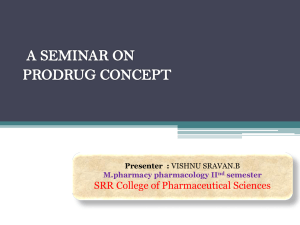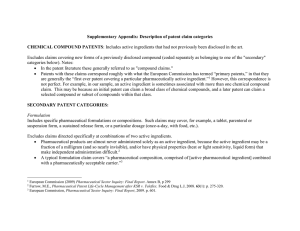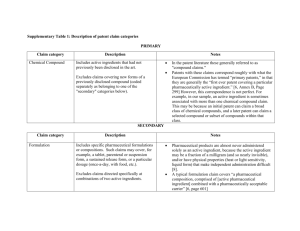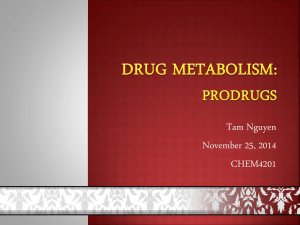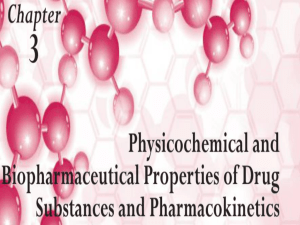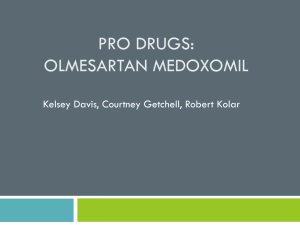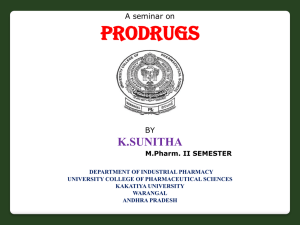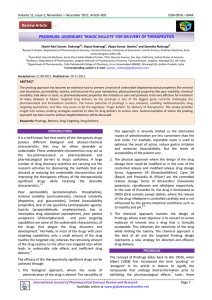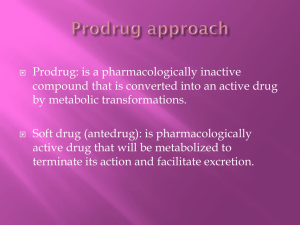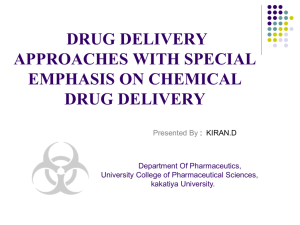Document 13309629
advertisement
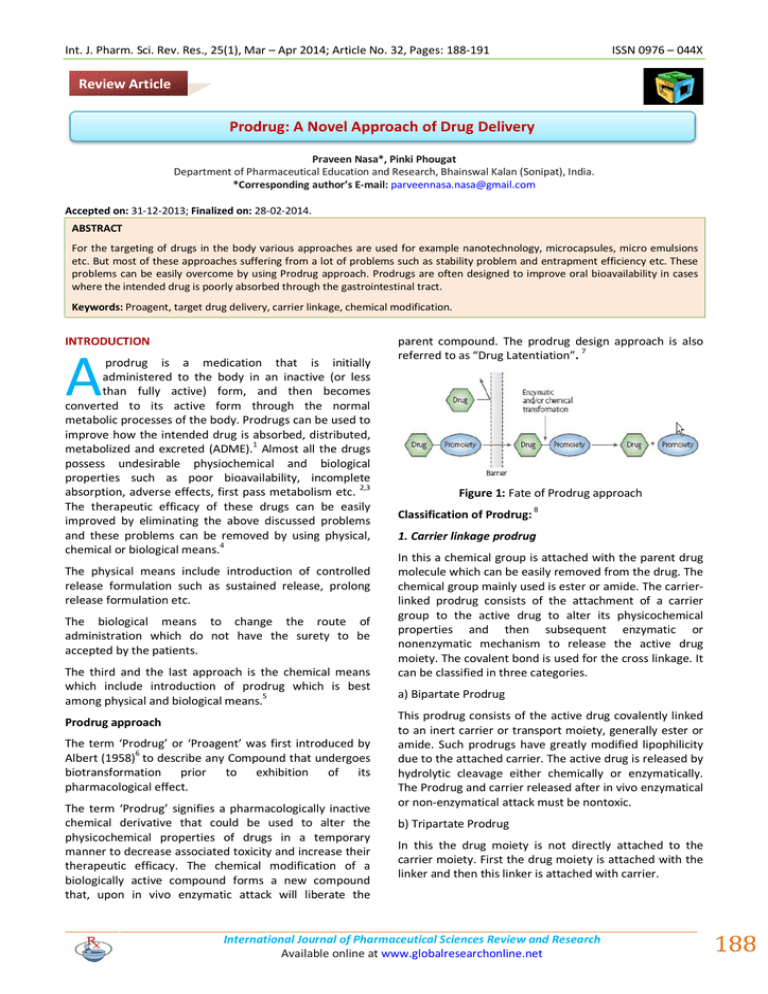
Int. J. Pharm. Sci. Rev. Res., 25(1), Mar – Apr 2014; Article No. 32, Pages: 188-191 ISSN 0976 – 044X Review Article Prodrug: A Novel Approach of Drug Delivery Praveen Nasa*, Pinki Phougat Department of Pharmaceutical Education and Research, Bhainswal Kalan (Sonipat), India. *Corresponding author’s E-mail: parveennasa.nasa@gmail.com Accepted on: 31-12-2013; Finalized on: 28-02-2014. ABSTRACT For the targeting of drugs in the body various approaches are used for example nanotechnology, microcapsules, micro emulsions etc. But most of these approaches suffering from a lot of problems such as stability problem and entrapment efficiency etc. These problems can be easily overcome by using Prodrug approach. Prodrugs are often designed to improve oral bioavailability in cases where the intended drug is poorly absorbed through the gastrointestinal tract. Keywords: Proagent, target drug delivery, carrier linkage, chemical modification. INTRODUCTION A prodrug is a medication that is initially administered to the body in an inactive (or less than fully active) form, and then becomes converted to its active form through the normal metabolic processes of the body. Prodrugs can be used to improve how the intended drug is absorbed, distributed, metabolized and excreted (ADME).1 Almost all the drugs possess undesirable physiochemical and biological properties such as poor bioavailability, incomplete absorption, adverse effects, first pass metabolism etc. 2,3 The therapeutic efficacy of these drugs can be easily improved by eliminating the above discussed problems and these problems can be removed by using physical, chemical or biological means.4 The physical means include introduction of controlled release formulation such as sustained release, prolong release formulation etc. The biological means to change the route of administration which do not have the surety to be accepted by the patients. The third and the last approach is the chemical means which include introduction of prodrug which is best 5 among physical and biological means. Prodrug approach The term ‘Prodrug’ or ‘Proagent’ was first introduced by Albert (1958)6 to describe any Compound that undergoes biotransformation prior to exhibition of its pharmacological effect. The term ‘Prodrug’ signifies a pharmacologically inactive chemical derivative that could be used to alter the physicochemical properties of drugs in a temporary manner to decrease associated toxicity and increase their therapeutic efficacy. The chemical modification of a biologically active compound forms a new compound that, upon in vivo enzymatic attack will liberate the parent compound. The prodrug design approach is also 7 referred to as “Drug Latentiation”. Figure 1: Fate of Prodrug approach Classification of Prodrug: 8 1. Carrier linkage prodrug In this a chemical group is attached with the parent drug molecule which can be easily removed from the drug. The chemical group mainly used is ester or amide. The carrierlinked prodrug consists of the attachment of a carrier group to the active drug to alter its physicochemical properties and then subsequent enzymatic or nonenzymatic mechanism to release the active drug moiety. The covalent bond is used for the cross linkage. It can be classified in three categories. a) Bipartate Prodrug This prodrug consists of the active drug covalently linked to an inert carrier or transport moiety, generally ester or amide. Such prodrugs have greatly modified lipophilicity due to the attached carrier. The active drug is released by hydrolytic cleavage either chemically or enzymatically. The Prodrug and carrier released after in vivo enzymatical or non-enzymatical attack must be nontoxic. b) Tripartate Prodrug In this the drug moiety is not directly attached to the carrier moiety. First the drug moiety is attached with the linker and then this linker is attached with carrier. International Journal of Pharmaceutical Sciences Review and Research Available online at www.globalresearchonline.net 188 Int. J. Pharm. Sci. Rev. Res., 25(1), Mar – Apr 2014; Article No. 32, Pages: 188-191 Figure 2: Mechanism of Tripartate Prodrug ISSN 0976 – 044X 2. The active doses of two mutual prodrugs of the same parent drugs may appear to be same in rats but may be quite different in clinical investigations.9 3. The prodrug might consume a vital cell constituent such as glutathione during its activation stage which causes depletion of prodrug.10 APPLICATIONS OF PRODRUG APPROACH Figure 3: Example of Tripartate Prodrug c) Mutual prodrug In this the carrier used is another biologically active drug instead of some inert molecule. A mutual prodrug consists of two pharmacologically active agents which are coupled together in such a way to act as a promoiety for the other agent and vice versa. The carrier selected may have the same biological action as that of the parent drug and thus might give synergistic action, or the carrier may have some additional biological action that is lacking in the parent drug, thus ensuring some additional benefit. 2) Bioprecursor Prodrug This approach does not include any carrier molecule. In this an inactive drug undergoing chemical modification to convert into a compound which itself is active drug or further metabolized into active form which have a desired therapeutic efficacy. The chemical reaction occurs in this process include oxidation or reduction. For e.g: Prontosil is an inactive compound which undergo metabolic reduction to produce sulphanilamide which is an active compound having antibacterial activity. Figure 4: Example of Bioprecursor Prodrug Prodrug approach has been extensively studied for a wide range of applications. It has been widely used now a day for its property of correction of pharmacokinetic as well as pharmaceutical, organoleptic, physical and chemical properties of parent drug compound which enhance the stability and patient compliance. The applications of prodrug are as follows. 1. Brain Targeting The hydrophilic drugs cannot be administered as such in the brain and thus the therapeutic efficacy cannot be achieved. The hydrophilic drugs can be converted into their lipophilic forms achieve the goal but this leads to the systemic toxicity due to the penetration of drugs into the other tissues. For this reason dihydropridine pyridinium type redox system was developed for brain specific sustained delivery of drug. The drug containing amine group is made lipophilic by coupling to dihydropyridine promoiety that facilitate penetration of prodrug through the blood brain barrier. In the CNS dihydropridine group converted to polar pyridinium salt, thus becomes poorly permeable to blood brain barrier and thus remain at the site and cleavage provides sustained release for action.11 2. Colon Targeting For e.g. sulphasalazine which is formed by coupling of diazotized sulphanilamide pyridine with 5-amino salicylic acid (ASA). On oral administration intact sulphasalazine reaches the colon. The azo reductase associated with colonic microflora convert sulphasalazin to its constituents entities, the active species 5ASA available for absorption in colon, while precolonic absorption responsible for side effects is reduced11. Advantages of prodrug: 3. To enhance aqueous solubility 1. It reduces adverse effects of drug. Limitations associated with prodrug approach: Prodrug can be used to increase the aqueous solubility of poorly aqueous soluble drugs. Prednisolone is a poorly aqueous soluble drug which should be converted into water soluble form for their delivery into the body. So this can be done by preparation of prodrug i.e prednisolone phosphate which is activated in vivo by the phosphotase.12-14 1. Formation of toxic metabolites: 4. Odour masking The main limitation of produg is the formation of toxic unexpected metabolites which are produced from the total drug conjugates. Another problem is the release of pharmacokinetic modifier which may cause enzyme induction or alter drug excretion. The odour of a compound is due to its vapour pressure. Low boiling point liquids will have a strong odour e.g. Ethyl mercapta having a Foul smell liquid of boiling point 35°C useful in the treatment of leprosy. Its foul smell is removed by converted it into its phthalate ester, diethyl isophthalate, which has higher boiling point and odorless.15, 16 The prodrug is administered by rubbing on 2. Drug can be targeted to the desired sites. 3. Synergistic effects can be obtained without side effects. 4. Give additional biological action as that of parent drug. International Journal of Pharmaceutical Sciences Review and Research Available online at www.globalresearchonline.net 189 Int. J. Pharm. Sci. Rev. Res., 25(1), Mar – Apr 2014; Article No. 32, Pages: 188-191 ISSN 0976 – 044X the skin, after absorption, the ester is metabolized to parent drug by thioesterase. esterification of the polar carboxylate group to form lipophilic, enzymatically labile esters. 5. Reduction of gastrointestinal irritation Enalapril is the ethyl ester prodrug of the active diacid, enalaprilat. Enalaprilat is poorly absorbed from the gastrointestinal tract (less than 10%), but absorption of the prodrug enalapril is greatly improved (about 60%). Many drugs react with the acid secretion in stomach and causes gastric irritation for e.g NSAIDS. In case of NSAIDS this problem can be overcome by preparation of prodrug salsalates. 6. Drug targeting When the drug is administered after its absorption it will distribute to different tissues including target as well as non targeting tissues. The distribution to non target tissues causes toxicity and reduction of drug concentration in the target tissues due to which optimum therapeutic action can not be achieved. So for obtaining desired therapeutic action drug targeting is necessary and this can be easily achieved by prodrug approach. 7. Reduction of stability problem Most of the drugs may be rapidly metabolized and rendered inactive before it reaches the site of action. The structure may be modified to block the metabolism until the drug is at the desired site. Some prodrugs protect the drug from first-pass effect. For e.g: Propranolol, (R=R1=H) is a widely used antihypertensive drug, but its oral bioavalability is very low because of first pass metabolism. The hemisuccinate ester of propranolol (R=H R‟=, COCH2COOH) was prepared to block glucuronide formation. Hence oral administration of propranolol hemisuccinate elevates plasma levels of propranolol for about 8 times.12-14 Dopamine cannot be distributed into the central nervous system (CNS) as it cannot cross the blood-brain barrier. But dopamine is essential for the treatment of Parkinson’s disease. Thus its prodrug levodopa is used for the treatment of Parkinson’s disease. Levodopa can easily cross the blood-brain barrier via an amino acid carrier and is then converted (decarboxylated) into dopamine by dopa decarboxylase in the CNS. CONCLUSION Recently many drugs have been formulated by using prodrug approach. Synthesizing a new compound is a very time consuming and also a costly one, but by using prodrug approach derivatives of compound can be easily prepared which is less time consuming and economical also. By using this approach the toxic effects associated with other approaches can be minimized. This approach not only improves the pharmacokinetic properties but also target the drugs on the specific site. REFERENCES 1. Miles Hacker, William S. Messer II, Kenneth A. Bachmann Pharmacology: Principles and Practice, first edition, Academic Press, UK, 2009, 216-217. 2. Many drugs have unpleasant taste, odour and some may causes GIT irritation and when given in form of injection causes pain. These problems cause poor patient compliance. Malhotra B, Gandelman K, Sachse R, Wood N, Michel MC: The design and development of fesoterodine as a prodrug of 5-hydroxymethyl tolterodine (5-HMT), the active metabolite of tolterodine, Curr Med Chem, 16(33), 2009, 4481-9. 3. Stella VJ, Charman WN, Naringrekar VH. Prodrugs: Do they have advantages in clinical practical drugs?, 29(5), 1985, 455–73. Table 1: Examples of Prodrug and their active metabolites17 4. http://www.wikipedia.com/PharmaceuticalProdrugMitul Shah / Pharmaceutical.htm 5. Brahmankar DM, Jaiswal SB. Biopharmaceutics and Pharmacokinetics- A Treatise., Vallabh Prakashan, first edition, Delhi, 1995, 162-168. 6. Albert A., Chemical aspects of selective toxicity, Nature, 182(4663), 1958, 421-423. 7. Harper N.J., Drug Research, 4, 1962, 221-224. 8. Williams DA., Foye Principles of Medicinal Chemistry, Lippincott Williams and Wilkins Publishers, 5thEd. Philadelphia, PA, 2002, 434-452. 9. Longqin Hu, Prodrug: Effective solutions for solubility, permeability and challenges, Drugs, 7(8), 2004, 2004, 736742. 10. Jha V, Chugh KS., Drug induced renal diseases, J. Assoc. Physician India, 43(6), 1995, 407-21. 8. Increase in patient compliance Prodrug Protonsil Active Drug Sulfanilamide Levodopa Talampicillin Cyclophosphamide Diazepam Azathioprine Cortisone Dopamine Ampicillin Phosphoramide mustard Oxazepam Mercaptopurine Hydrocortisone Dipivefrin Prednisone Enalapril Adrenaline Prednisolone Enalaprilat Some detailed examples of prodrugs16 Pivampicillin, talampicillin and bacampicillin are all prodrugs of ampicillin. These prodrugs are produced by International Journal of Pharmaceutical Sciences Review and Research Available online at www.globalresearchonline.net by 190 Int. J. Pharm. Sci. Rev. Res., 25(1), Mar – Apr 2014; Article No. 32, Pages: 188-191 11. Swarnlata Saraf, Prodrug: A Sustained Chemical Drug Delivery Approach, Pharmaceutical Information Reviews, 5(6), 2007. 12. Kumpulainen, Hanna-Maarit S., Novel Prodrug Structures for Improved Drug Delivery. Kuopio University Publications, A Pharmaceutical Sciences, 104, 2007, 129. 13. Singh H, Kapoor VK, Medicinal and Pharmaceutical Chemistry, Vallabh Prakashan, 2nd Edition, Delhi, 2005, 264-280. 14. Verma Alka, Verma Bhupesh, Prajapati Sunil, Tripathi Kishu, Prodrug as a chemical delivery system: A Review, Asian J. Research Chem., 2(2), 2009, 100. ISSN 0976 – 044X 15. Hyo-Kyung Han and Gordon Pharmscitech, 2(1), 2000, 1-11. L. Amidon, AAPS 16. 16. Tegeli VS., Thorat YS., Review on Concepts and Advances in Prodrug Technology, International Journal of Drug Formulation & Research, 1(3), 2010, 32-57. 17. http://epharmacology.hubpages.com/hub/Pharmacologic al-Effects-Prodrugs-Definition-Examples-and-Sources-ofDrug-Information. Source of Support: Nil, Conflict of Interest: None. International Journal of Pharmaceutical Sciences Review and Research Available online at www.globalresearchonline.net 191
